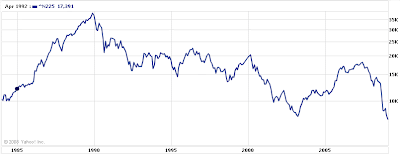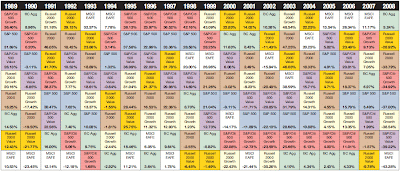If you believe these arguments, how does one create an actionable investment strategy? The first step is often overlooked: consider if you should be investing at all. Individuals need to reassess the wisdom of carrying debt while simultaneously investing in stocks. This approach creates implicit leverage in your investment strategy, which will magnify the gains as well as the losses. It is one thing for corporations and hedge funds to employ leverage, but I do not think such a strategy is appropriate for most households. If you have car loans, credit card debt, or even some student loans at a high rate of interest, they should always be paid off before you start investing.
The mortgage payoff question is less clear cut. The expected return from paying off your mortgage may be lower than investing in stocks, but the mortgage is a risk-free investment. Consider: if it were a no-brainer to take a large mortgage and invest the money in the stock market, why would banks even bother writing mortgages? They could be much more profitable by just investing those funds directly in stocks. The interest tax deduction is frequently evangelized, but the true value of it actually depends on your marginal tax rate as well as the size of the standard deduction versus your itemized deductions. Even if you do get a deduction for it, does it make sense to pay $1.00 in interest to save $0.25 in taxes? You’d still be better off it you had never spent the $0.75 in the first place. It is also worth considering that if you have $100,000 and you give it to your financial adviser to invest, he will earn an annual fee on those funds. If you use it to pay down your mortgage, your financial adviser receives no commission. So what course of action are most advisers going to recommend?
On the other hand, it probably makes sense to prioritize tax-advantaged accounts like the Roth IRA ahead of the mortgage paydown, since there is a limited window for contributions to a Roth IRA (each tax year forces you to “use it or lose it” as there are no retroactive contributions). Similarly, 401k contributions necessary to receive your employer’s matching funds should also take priority over mortgage elimination. But blithely putting as much as you possibly can in a 401k or IRA just because it has some tax advantages is sub-optimal for most investors.
Once the decision to invest has been made, the percentage in stocks and bonds must be determined. Unfortunately, I don’t have a grand unified theory of asset allocation. The best starting point is using traditional mean-variance optimization from modern portfolio theory to create the efficient portfolio. The output would look something like this (the actual output would differ from this graph because I would include asset returns and correlations prior to 1970 up through the present day):

My point here is not that the traditional approach to portfolio construction is flawed; the output (the graph) is reasonable, but the interpretation of the results leads investors astray. This graph tends to make people think that a higher percentage investment in stocks guarantees them a higher return over the long run. A fancy graph makes anything more believable due to the “quantification of fantasy” principle. So investors pick a risky asset allocation that is on the right side of the curve, because that is where you get the highest expected return for each unit of risk (approximately 80% stocks, 20% bonds). However, I believe that for the vast majority of individual investors – those who are financially unsophisticated and saving towards retirement or other long-term goals – the optimal portfolio favors minimizing variance rather than maximizing return/risk. That occurs at the left-most point on the graph - 25% stocks, 75% bonds.
Therefore, the appropriate mix of stocks versus bonds would almost certainly lower than the "bond allocation equals your age" rule of thumb that many use (i.e. if you are 25 years old, you should hold 25% of your assets in bonds). For someone nearing retirement, it is probably lower than the 53% allocated to stocks by Vanguard's Target Retirement 2010 fund. For a young person in their 20's or 30's, it is probably much less than the 90% allocated to stocks by Vanguard's Target Retirement 2050 fund. A very rough estimate of my generally recommended portfolio would invest one-third of its value in each of the following asset classes:
- Equities, distributed between US, developed, and emerging markets
- Inflation protected securities, such as TIPS
- Other bonds like treasuries, corporate, and high-yield
This would be a time-independent allocation that would remain fixed throughout someone's accumulation phase, with a possible reduction in the equity exposure to 20% once the investor enters retirement. Annual rebalancing is assumed and the individual asset classes would be held in index mutual funds with low-cost, passive management.
Some will object to such a low allocation to equities (33%). They will say that over the long term, inflation will destroy the purchasing power of your portfolio. Personally, I think inflation has been used to scare many investors into holding more stocks than they should. If you look at equity returns from the 1970s when the US had high inflation, stocks held up better than bonds but I would hardly call them a good investment over the period. Nonetheless, inflation risk is a legitimate concern, and that is addressed by the 33% allocation to Treasury Inflation Protected Securities (TIPS). These are bonds issued by the US government that increase in value with inflation. Most investors are unfamiliar with them because the government doesn’t run TV commercials telling you to buy them and financial advisers have little incentive to push them due to their lower expected returns. However, they can help protect you from unexpected inflation and are as safe as any government bond (they have no credit risk). You can buy them directly from the Treasury for free, or you can purchase a mutual fund or ETF that manages them for you for a small fee. Because they are bonds, TIPS are best held in a tax-advantaged account like a 401k or IRA.
When times are good and stocks are posting double digit returns, no one feels the need to question how returns are being generated (see: Madoff, Stanford, et al). Investors’ skepticism goes out the window because they think there is easy money to be made. We are all prone to recency bias, believing that the future will look like the not-too-distant past. It is only when risk comes to the forefront that investors reevaluate their exposure to unfavorable outcomes. They realize that risk is not just a number on a page like standard deviation, it is a significant loss of wealth that can affect your quality of life. This also means that investors need to be extremely skeptical of anyone proposing a radical change in investment philosophy – acting out of fear is no better than acting out of greed. If the market drops 50% and you sell all your stocks, what will you do when it starts to recover? I believe it is far better to adopt a reasonable, consistent plan of saving and investing that allows some upside but more importantly, protects you from the disastrous downside. The ideas in this paper are not new; many of them are condensed from arguments made by Paul Samuelson and Zvi Bodie, among others. I appreciate their efforts in challenging the conventional wisdom.















